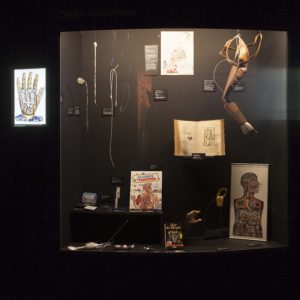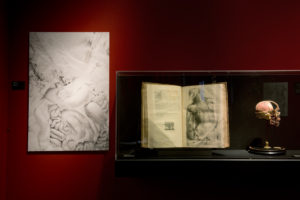
Curated with Roxanne Currat and Carolina Liebling
2014
Musée de la main UNIL-CHUV (Fondation Verdan), Lausanne
2014-2015
Anatomisches Museum, Basel
2015-2016
Kulturama, Zurich
Anatomies is a transdisciplinary exhibition about the historical and contemporary conceptions and representations of the body in biology and medicine, and how sociological, pedagogical and artistic aspects fashion these representations.
Interactive, contemplative and immersive, the exhibition offers an exploration of the concepts of the human body. The visitors discover an anthology of images, objects, testimonies, both contemporary and historical, belonging as much to art as to science. From Renaissance books to the latest imaging technologies and from anatomical preparations to art installations, Anatomies offers a broad-ranging overview of anatomical representations in six sections.
The first section, Visions of the body, points out to the perspectives and approaches that effectively shape our anatomy, from philosophy to medicine, religion and politics. Explorations, the second section, is reminiscent of the first anatomical theatres, and outlines the history of anatomy in the Western World, which took off in the particular context of an era that explored the world, sketched it and printed it, relying more and more on observation to make sense of it.
Opening the body retraces the gestures and ceremonials associated with dissection from the Middle Ages to nowadays while Imaging the body presents the evolution of the depictions of anatomy, from drawing (a technique still relevant in the 21st century) to the latest technologies currently used in medicine. Interpretations demonstrate how such images are not immediate and need to be deciphered and interpreted. A final section, Awe and fascination, reflects on how unveiling the anatomy of the human body remains an unsettling experience, both appealing and repulsive.
Anatomies est une exposition interdisciplinaire sur les conceptions et représentations historiques et contemporaines du corps humain en biologie et médecine, et comment la sociologie, la pédagogie et l’art influencent ces repésentations.
Interactive, contemplative et immersive, l’exposition propose une exploration des conceptions et représentations du corps humain. Le visiteur y découvre un florilège d’images, d’objets et de témoignages entre passé et présent, art et science, médecine et société. Des ouvrages anciens aux technologies d’imagerie les plus récentes, des préparations anatomiques aux installations d’artistes, Anatomies invite à traverser les multiples miroirs de nos corps intérieurs en six sections.
La première, Visions du corps, pointe sur les conceptions multiples du corps qui coexistent et parfois se contredisent, issues de la philosophie, religion, médecine, politique. Explorations, la seconde, prend place au sein d’une scénographie rappelant les premiers théâtres anatomiques, présente les débuts de l’histoire de l’anatomie en Occident, fruit d’une époque qui explore le monde, repense le cosmos, et diffuse largement son savoir grâce aux progrès de l’imprimerie.
Ouverture du corps retrace les gestes et rituels entourant la dissection du Moyen Age jusqu’à nos jours, alors qu’Images du corps présente les évolutions techniques et esthétiques de l’imagerie médicale de l’anatomie. Interprétations démontre comment ces images ne sont pas immédiates, mais requièrent une interprétation. Enfin, Fascination et effroi se penche sur les émotions fortes suscitées par le dévoilement de l’anatomie et nos sentiments ambivalents face à ce spectacle extraordinaire.










Images: Olga Cafiero or Myriam Ziehli & Simon Rimaz